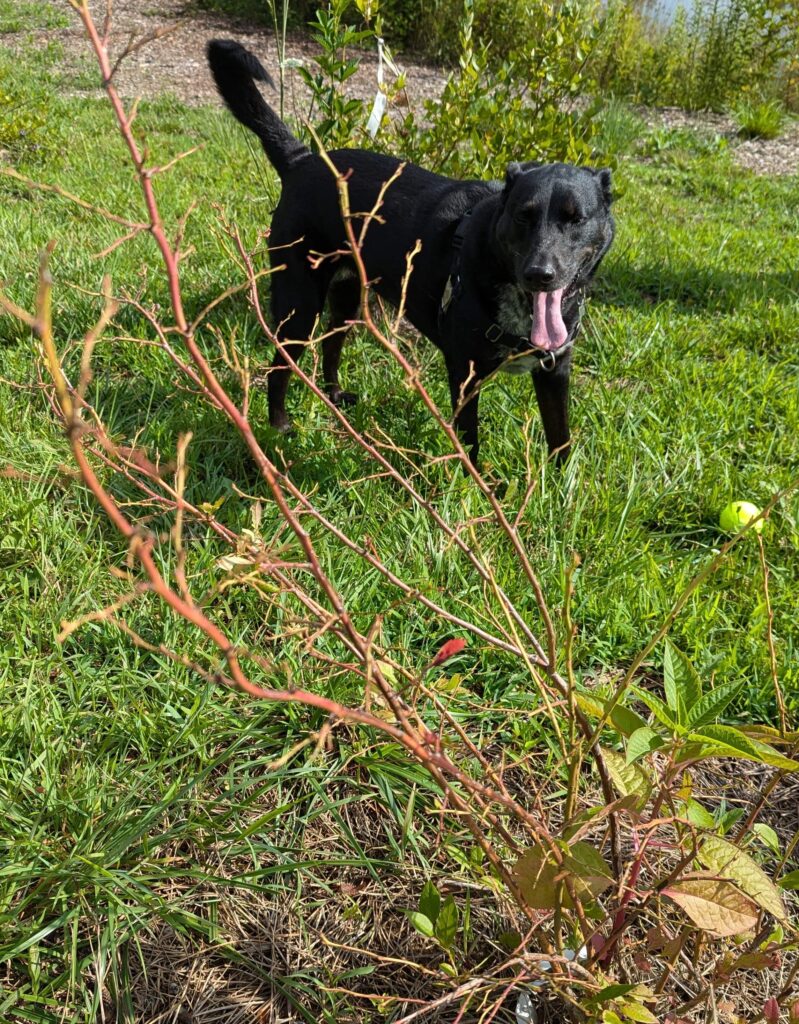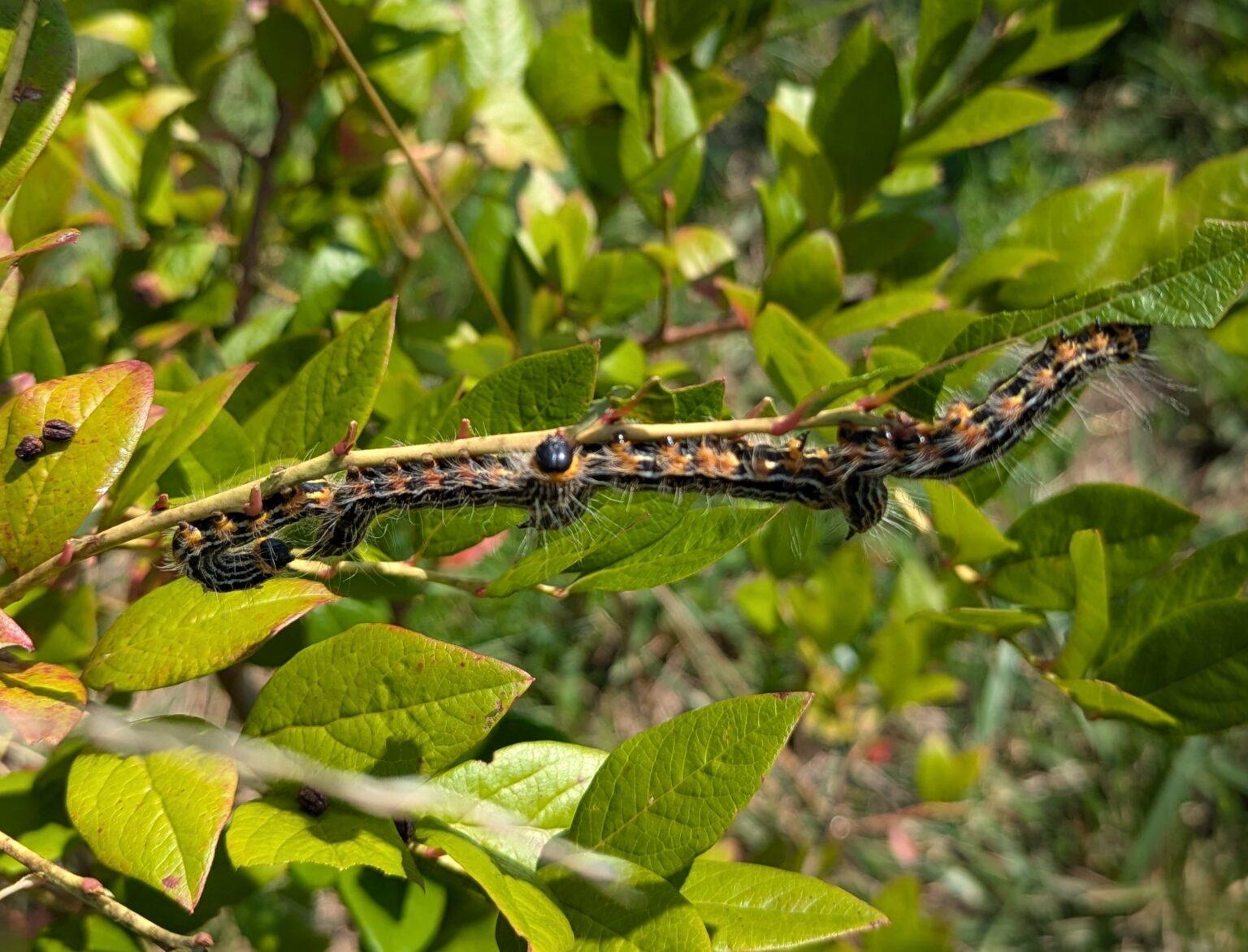We get plenty of pests in our home garden. It helps to be able to identify what you’ve found, so you know which plants may be at risk and then how they should be dealt with! For this week, I highlight two pests I find in my North Carolina property that seem similar at first blush, but are quite different! Here’s some more information about the yellow-necked caterpillar and sawfly larva.
A Troublesome Caterpillar
The yellownecked caterpillar, Datana ministra, occurs frequently on oaks, birches and other hardwoods. Young caterpillars are small green worms that grow into orange worms with yellow stripes and then into large (about 2 inches long), black-and yellow striped caterpillars with black heads and reddish prolegs. The body is covered by long, fine, white hairs. Behind the head is a bright yellow to orange patch from which this insect’s common name is derived. Moths emerge from the soil during June and July to lay eggs.
Oaks are among the favorite hosts of yellownecked caterpillars, although it also feeds on basswood, birch, elm, honey locust, maple, mountain-ash, walnut and witchhazel. This insect is also destructive on blueberry, apple, and other fruit trees.
Because yellownecked caterpillars feed gregariously, they can be dislodged from low branches and drowned in water and soap. Spray plants with a solution of Bt (Bacillus thuringiensis) or azadirachtin when caterpillars first appear. On large trees where sprays do not provide adequate coverage, a solution of AzaSol (6% azadirachtin) can be applied by tree injection. Left unchecked, the caterpillars can completely defoliate plants.

The larvae typically feed in groups near the ends of the twigs and branches. When disturbed the whole group often elevates both ends of the body, a behavior that predators might find intimidating. Another species that has the same alarm behavior is the sawfly.

When a Caterpillar is Not a Caterpillar!
At least two species of sawflies, Neopareophora litura and Pristiphora cincta, are known to feed on wild blueberry plants. These wasp-like insects are small and black, and can be seen resting on or flying around plants in June. Their larvae are pale green and shiny with a black head, and appear in April–May and again in July – August.
Sawflies also feed on the foliage of trees including pine, dogwood, balsam fir and elm. Sawflies have host preferences, however. For example, the European pine sawfly and the European spruce sawfly prefer the foliage of conifer species. Pine is the most common host of these species, but they will also feed on arborvitae, cypress, fir, hemlock, juniper, larch, and spruce. Much like the yellow-necked caterpillar, these also feed gregariously. The larvae look a lot like and can be mistaken for a caterpillar.
Although larvae resemble caterpillars, they are members of an entirely different family of insects: the Hymenoptera. Sawflies are in the same family as ants, wasps and bees! Their name derives from the female appendage that works to deposit eggs into plant foliage or the sapwood of a tree. Most leaf-feeding larvae have six or more pairs of prolegs on the abdomen and one large “eye” on each side of the head. In contrast, caterpillars, (the larvae of moths and butterflies) have three pair of true legs and a variable number of prolegs, depending on species.
A species of sawfly that bores into the wood of a tree is known as a horntail or wood wasp, or a Siricid. The Sirex wood wasp (Sirex noctilio) is an invasive wood borer of pine trees. A native of Europe, Asia and north Africa it was discovered in 2004 infesting pine in New York State and in northern counties of Pennsylvania. It attacks red, loblolly, slash, ponderosa, lodgepole and Monterey pines. Though less preferred it will also attack white pine.
Even though sawfly larvae resemble caterpillars, they are not controlled with Bacillus thuringiensis (Bt), a biological control that is very effective against moth and butterfly caterpillars. Organic pesticides that are effective foliar treatments include azadirachtin, neem and spinosad. Apply early, when larvae first appear for best control. In trees too large to spray, stem injection of a registered insecticide such as ACE-jet (15% acephate) may be considered.
Always read and follow label directions before using any pesticide!
Next week we’ll ponder a deep topic – ponds!
~ Signing off for now, Joe

